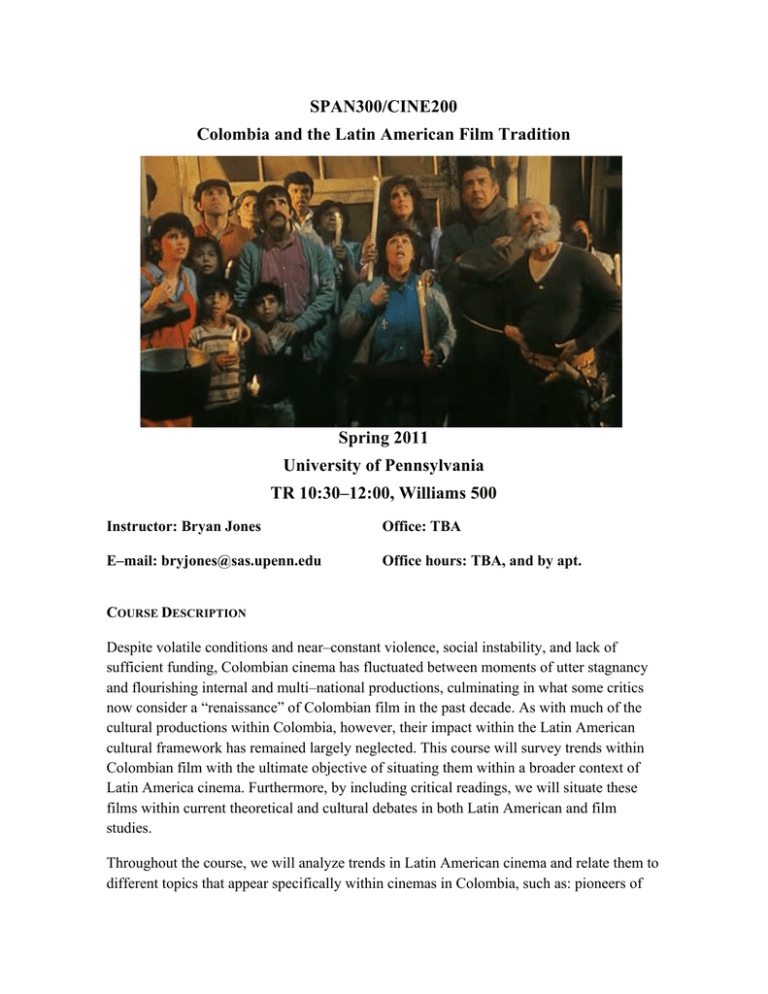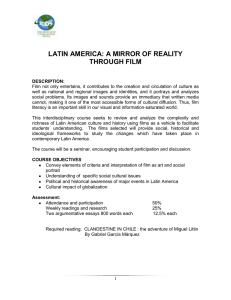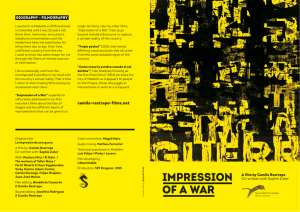SPAN300/CINE200 Colombia and the Latin American Film Tradition
Anuncio

SPAN300/CINE200 Colombia and the Latin American Film Tradition Spring 2011 University of Pennsylvania TR 10:30–12:00, Williams 500 Instructor: Bryan Jones Office: TBA E–mail: [email protected] Office hours: TBA, and by apt. COURSE DESCRIPTION Despite volatile conditions and near–constant violence, social instability, and lack of sufficient funding, Colombian cinema has fluctuated between moments of utter stagnancy and flourishing internal and multi–national productions, culminating in what some critics now consider a “renaissance” of Colombian film in the past decade. As with much of the cultural productions within Colombia, however, their impact within the Latin American cultural framework has remained largely neglected. This course will survey trends within Colombian film with the ultimate objective of situating them within a broader context of Latin America cinema. Furthermore, by including critical readings, we will situate these films within current theoretical and cultural debates in both Latin American and film studies. Throughout the course, we will analyze trends in Latin American cinema and relate them to different topics that appear specifically within cinemas in Colombia, such as: pioneers of 2 (silent) film, Pornomiseria and Colombia’s neo-neorealism, Caliwood and the Grupo de Cali, (im)migrations and the displaced, narco-cinema, and documentary. The course will be given in Spanish. Not all of the films have English subtitles. Readings will be in English and Spanish. Students are required to complete several short written assignments, an oral presentation, as well as a final oral exam. COURSE OBJECTIVES Students will be introduced to significant films from the Latin Ameican cinema canon, and they will relate the overarching themes and techniques from these films to distinct and similar approaches that appear in Colombian cinema. By the end of the course, students should be able to identify the main trends we discuss from Latin American films as well as the specific idiosyncrasies of cinema produced within Colombia. COURSE PREREQUISITES – Completion of Spanish 219 – Advanced Spanish Language Skills – A desire to learn about Latin American literature and film REQUIRED TEXTS Books: King, John. Magical Reels: A History of Cinema in Latin America. Second Edition. London: Verso, 2000. Stock, Ann, ed. Framing Latin American Cinema: Contemporary Critical Perspectives. Minneapolis: U of Minnesota P, 1997. Suggested Background Reading: Barsam, Richard, and Dave Monahan. Looking at Movies: An Introduction to Film. Third Edition. W. W. Norton & Company, 2009. 3 Corrigan, Timothy. A Short Guide to Writing about Film. Seventh Edition. New York: Longman, 2009. Articles: All required crticial essays and articles will be accessible through Blackboard. REQUIRED SCREENINGS Students will be required to view approximately 15 feature-length films throughout the semester. While we will focus on one feature-length film most weeks, some weeks we will discuss two films. Students should plan ahead as needed. There is a theatrical screening on Mondays at 5:00 pm in Williams 500. Students who cannot attend the group screening are responsible for viewing the film on their own by other means such as in the Rosengarten Reserve or online using Netflix (when available). Remember, it is your responsibility to locate and watch the film(s) prior to the corresponding class. Jan 18–20 Selection of Silent Films from Latin America Bajo el cielo antioqueño (Arturo Acevedo Vallarino, 1925) Jan. 25–27 Los olvidados (Luis Buñuel, 1950) Selection of Italian Neorealism Clips (in-class) Feb. 1–3 Agarrando pueblo (Carlos Mayolo, 1978) Gamín (Ciro Durán, 1979) (Clips) Pixote (Hector Babenco, 1981) Feb. 8–10 Rodrigo D: No futuro (Víctor Gaviria, 1990) Feb.15–17 Cidade de Deus (Fernando Meirelles, 2002) Feb. 22–24 La ley de Herodes (Luis Estrada, 1999) March 1–3 Perder es cuestión de método (Sergio Cabrera, 2005) 4 Carne de tu carne (Carlos Mayolo, 1983) SPRING BREAK March 15–17 Memorias del subdesarrollo (Tomás Gutiérrez Alea, 1968) Paraíso Travel (Simon Brand, 2008) March 22–24 La estrategia del caracol (Sergio Cabrera, 1990) Los viajes del viento (Ciro Guerra, 2009) March 29–31 María llena eres de gracia (Joshua Marston, 2004) April 5–7 La virgen de los sicarios (Barbet Shroeder, 2000) April 12–14 Tire dié (Fernando Birri, 1960) Chircales (Marta Rodríguez and Jorge Silva, 1968–72) April 19–21 La sierra (Scott Dalton and Margarita Martínez, 2005) Suite Habana (Fernando Pérez, 2003) COURSE REQUIREMENTS Attendance and Participation, 10% Attendance for the two weekly sessions is mandatory. Students earn attendance and participation points by attending the class sessions (3 absences are permitted) and by participating in the class discussions. Participation, of course, requires that students arrive at the each class having watched the feature film and prepared the assigned readings. Short Essays, 40% Students are required to complete and submit 3 short essays (3–5 pages) over the course of the semester. Keeping in mind relevant discussions from the class, each short essay should rigorously analyze a key element of a particular feature-film or compare a prominent aspect between different feature-films from the previous weeks. More information will be available during the semester. 5 Oral Presentation, 15% Each student will be required to prepare one oral presentation during the semester. The purpose of the oral presentation is to further the class discussions by analyzing supplementary films that fall into similar categories as the required screenings for the class. Students are encouraged to use audio-visual technology, but should remember that the focus of the oral presentation is to offer a relevant and insightful analysis of additional films from Latin America or Colombia. Available films are listed on the detailed syllabus below. Students may request other films pending instructor approval. More information will be available during the semester. Film Reviews, 15% Students will be required to submit two short film reviews (500–1000 words). Films should be chosen in the same way as the films for the oral presentations, and should not be the same film that the student will present to the class. Final Exam, 20% Students are required to learn to speak (in Spanish) about Latin American and Colombian cinemas as well as acquire a basic knowledge of their connections and/or discontinuities. As such, students are required to take a 20-minute oral exam during the final exam period. The format of the exam consists of 6–8 stills about which students will comment. In preparation for the exam students will have access to a bank of stills covering the most significant feature-films, historical and artistic movements, and technical developments that we have discussed in class. From this bank of 80–100 slides, 6–8 slides will be selected for the exam. Exams are taken individually with the instructor. Grading Scale: 83–86 B 98–100 A+ 80–82 B– 95–97 A 75–80 C 91–94 A– 70–74 D 87–90 B+ Below 70 F COURSE DISCLAIMERS Students who take this course should be aware of the following: – Spanish Language. Although this is not a Spanish language course, the course offers the possibilities of improving and maintaining Spanish languages skills in the following ways: o Oral comprehension. Students will watch and listen to approximately 25 hours of Spanish language cinema. Close attention to the dialogues and voiceovers will help students improve their Spanish comprehension skills. o Writing skills. Students will be required to turn in written the short papers and film reviews. These assignments will help students improve and maintain their written Spanish. o Speaking skills. In addition to regular class discussion during the recitation session, students will hone their speaking skills while preparing for the final oral exam in Spanish. o Reading Skills. Although many of the secondary readings are in English, students will be required or encouraged to read at least one article a week in Spanish. – This course deals with visual content that may be offensive for some students. As a political strategy, filmmakers often resort to violent images. They may also incorporate nudity or explicit sexual acts as a commentary on social conditions. Although usually unrated, most of the required films for the course would receive an R rating, some films might be considered among the X rated films, still many other would fall clearly beneath the GP rating. 7 – Laptop computers, iPads and other electronic devices. Students are not allowed to use these devices during the lecture or recitation sessions. There is much visual information disseminated during the class sessions. Spending time in class checking emails and surfing the web inevitably distracts from the visual content of the course. Moving images (screened at 15–30 frames per second) require close attention. Students who use laptops and electronic devices during class will not receive credit for class participation. 8 SPAN300/CINE200 Detailed Course Syllabus January 13 Course Introduction SILENT FILM AND THE PIONEERS Week 1: January 18–20 Films: Selection of Silent Films from Latin America Bajo el cielo antioqueño (Arturo Acevedo Vallarino, 1925) Readings: Gunning, Tom. “The Cinema of Attraction: Early Film, Its Spectator, and the Avant-Garde.” Film and Theory: An Anthology. Edited by Robert Stam & Toby Miller. Malden, MA: Blackwell Publishing, 2005: 229– 35. King, John. “Chapter 1: Rugged Features: The Silent Area.” Magical Reels: pp. 7–30. López, Ana M. “Early Cinema and Modernity in Latin America.” Cinema Journal. 40.1 (2000): 48–78. López Díaz, Nazly Maryith. Miradas esquivas a una nación fragmentada: Reflexiones en torno al cine silente de los años veinte y la puesta en escena de la colombianidad. Bogotá: Alcaldía Mayor de Bogotá D.C.: Instituto Distrital Cultura y Turismo, 2006. Salcedo Silva, Hernando. “Entrevista con Donato di Domenico.” Crónicas del cine colombiano, 1897–1950. Santafé de Bogotá: Valencia Editores, 1981: pp. 35–48. Oral Pres.: Alma Provinciana (Féliz Joaquín Rodríguez, 1926) Garras de oro (P. P. Jambrina, 1926) 9 NOT QUITE NEOREALISM: THE POLITICALLY MARGINALIZED ON THE BIG SCREEN Week 2: January 25–27 Films: Los olvidados (Luis Buñuel, 1950) Selection of Italian Neorealism Clips (in-class) Readings: Acevedo-Muñoz, Ernesto R. “Los olvidados: Luis Buñuel and the Crisis of Nationalism in Mexican Cinema.” Latin American Studies Association Annual Conference. Guadalajara, Mexico: April 17–19, 1997. Fornet, Ambrosio “Foreward.” Framing Latin American Cinema (Ed. Ann Marie Stock), pp. xi–xx King, John. “The 1960s and After: New Cinemas for a New World?.” Magical Reels: pp. 129–48. Ratner, Megan. “Italian Neo-Realism”. Green Cinema. <http://www.greencine.com/static/primers/neorealism1.jsp>. Stock, Ann Marie. “Introduction: Trhough Other Worlds and Other Times: Critical Praxis and Latin American Cinema.” Framing Latin American Cinema: pp. xxiii–xxxvi. Oral Pres.: El ángel exterminador (Luis Buñuel, 1962) Él (Luis Buñuel, 1953) Week 3: February 01–03 Films: Agarrando pueblo (Carlos Mayolo, 1978) Gamín (Ciro Durán, 1979) (Clips) Pixote (Hector Babenco, 1981) Readings: Burton, Julianne. “The Camera As ‘Gun’: Two Decades of Culture and Resistance in Latin America.” Latin American Perspectives, Vol. 5, No. 1, Culture in the Age of Mass Media. (Winter, 1978): pp. 49–76. Gómez, Felipe. “Guerrillas cinematográficas: La situación del documental en Colombia después de la Revolución cubana.” Luís Ospina: Centro de documentación digital. <http://luisospina.com/content/view/16/37/>. 10 Khan, Omar. “Desde la ‘pornomiseria’ hasta los circuitos comerciales.” El País. “Babelia.” 24 November 2007. <http://www.elpais.com/articulo/arte/pornomiseria/circuitos/comercial es/elpepuculbab/20071124elpbabart_8/Tes>. King, John. “Chapter 5: Brazil: Cinema Novo to TV Globo.” Magical Reels: pp. 105–28. Oral Pres.: La hora de los hornos (Fernando Solanas y Octavio Getino, 1968) Vidas Secas (Nelson Periera dos Santos, 1963) NEO–NOT QUITE–NEOREALISM? Week 4: February 08–10 Films: Rodrigo D: No futuro (Víctor Gaviria, 1990) Readings: Goldman, Ilene S. “Chapter 3: Recent Colombian Cinema: Public Histories and Private Stories.” Framing Latin American Cinema: pp. 58–77. Herlinghaus, Hermann. “Affectivity beyond ‘Bare Life’: On the NonTragic Return of Violence in Latin American Film.” A Companion to Latin American Literature and Culture. Edited by Sara Castro-Klarén. Malden, MA: Blackwell Publishers, 2008. 584–601. Pozo, Diego del. “Olvidados y re-creados: La invariable y paradójica presencia del niño de la calle en el cine latinoamericano.” Chasqui 32.1 (2003): 85–97. Oral Pres.: La vendedora de rosas (Víctor Gaviria, 1998) Week 5: February 15–17 Films: Cidade de Deus (Fernando Meirelles, 2002) Readings: Elbow, Gary S. “Three Recent Brazilian Films: A Review.” Journal of Latin American Geography 4.2 (2005): 125–131. Solanas, Fernando and Octavio Gettino. “Towards a Third Cinema.” Film and Theory: An Anthology. Edited by Robert Stam & Toby Miller. Malden, MA: Blackwell Publishing, 2005: 265–286. Oral Pres.: Al final del espectro (Juan Felipe Orozco, 2006) 11 El Colombian Dream (Felipe Aljure, 2005) IDENTITIES IN CORRUPTIONS Week 6: February 22–24 First Short Essay Due Films: La ley de Herodes (Luis Estrada, 1999) Readings: Hall, Stuart. “Cultural Identity and Diaspora.” Identity: Community, Culture, Difference. Edited by Jonathan Rutherford. London: Lawrence & Wishart, 1990. 222–37. Hind, Emily. “Provincia in Recent Mexican Cinema, 1989–2004.” Discourse 26.1 (2004): 26–45. King, John. “Mexico: Inside the Industrial Labyrinth.” Magical Reels: pp. 129–48. Oral Pres.: Canoa (Felipe Cazals, 1976) Historia del baúl rosado (Libia Stella Gómez, 2005) Week 7: March 01–03 First Film Review Due Films: Perder es cuestión de método (Sergio Cabrera, 2005) Carne de tu carne (Carlos Mayolo, 1983) Readings: Gómez Ocampo, Gilberto. “The Persistance of Vision: Going to the Movies in Colombia.” Framing Latin American Cinema: pp. 175–85. Modleski, Tania. “The Terror of Pleasure: The Contemproary Horror Film and Postmodern Theory.” Film Theory and Criticism. Edited by Leo Braudy & Marshall Cohen. Sixth Edition. New York: Oxford U P, 2004: pp. 764–773. Oral Pres.: La mansión de Araucaima (Carlos Mayolo, 1986) Golpe de estadio (Sergio Cabrera, 1998) 12 Week 8: March 08–10 Spring Break MIGRATIONS: THE MARGINALIZED DISPLACED Week 9: March 15–17 Films: Memorias del subdesarrollo (Tomás Gutiérrez Alea, 1968) Paraíso Travel (Simon Brand, 2008) Readings: Campa, Román de la. “Memorias del subdesarrollo: Novela/Texto/Discurso.” Hispamérica 15.44 (1986): 3–18. King, John. “Chapter 7: Cuba: Revolutionary Projections.” Magical Reels: pp. 145–68. Oral Pres.: Bolivia (Israel Adrián Caetano, 2001) Visa USA (Lisandro Duque Naranjo, 1986) Week 10: March 22–24 Films: La estrategia del caracol (Sergio Cabrera, 1990) Los viajes del viento (Ciro Guerra, 2009) Readings: García Canclini, Néstor. “Will There Be Latin American Cinema in the Year 2000? Visual Culture in a Postnational Era.” Framing Latin American Cinema: p. 247–59. King, John. “Chapter 10: Colombia and Venezuela: Cinema and the State.” Magical Reels: pp. 207–224. King, John. “Cinema in the Nineties: The Snail’s Strategy.” Magical Reels, pp. 253–297. Oral Pres.: Sin nombre (Cary Joji Fukunaga, 2009) La sombra del caminante (Ciro Guerra, 2004) 13 VIOLENCE ON FILM: NARCO-CINEMA AND SOCIAL VIOLENCE Week 11: March 29–31 Second Short Essay Due Films: María llena eres de gracia (Joshua Marston, 2004) Readings: Alvaray, Luisela. “National, Regional, and Global: New Waves of Latin American Cinema.” Cinema Journal 47.3 (2008): 48–65. González del Pozo, Jorge. “María llena eres de gracia: Inmigración, narcotráfico y las promesas de la globalización.” Hispanet Journal, 3 (December 2010). James, David. “Is There Class in this Text? The Repression of Class in Film and Cultural Studies.” A Companion to Film Theory. Edited by Toby Miller & Robert Stam. Malden, MA: Blackwell Publishing, 2004: pp. 182–201. Oral Pres.: La teta asustada (Claudia Llosa, 2009) Como el gato y el ratón (Rodrigo Triana, 2002) Week 12: April 05–07 Films: La virgen de los sicarios (Barbet Shroeder, 2000) Readings: Herlinghaus, Hermann. “Young, Alien, and Totally Violent: Marginal ‘Kings of the World’” Violence Without Guilt: Ethical Narratives from the Global South. New York: Palgrave Macmillan, 2009: pp. 105–34. ———. “Autobiography as Eschatological Project: An Intellectual Struggle Regarding Freedom and Guilt.” Violence Without Guilt: Ethical Narratives from the Global South. New York: Palgrave Macmillan, 2009: pp. 135–68. Oral Pres.: Rosario Tijeras (Emilio Maillé, 2005) Perro come perro (Carlos Moreno, 2007) 14 THE ART OF DOCUMENTARY: TOWARDS A CINEMA OF TRUE REPRESENTATION Week 13: April 12–14 Second Film Review Due Films: Tire dié (Fernando Birri, 1960) Chircales (Marta Rodríguez and Jorge Silva, 1968–72) Readings: Birri, Fernando. “El manifiesto de Santa Fe.” Cine Documental en América Latina. Edited by Paulo A. Paranaguá and José C. Avellar. Madrid: Cátedra, 2003: pp. 456–57. Dias D’Almeida, Alfredo and Vanderlei Henrique Matropaulo. “El documental del Nuevo Cine Latinoamericano: Una toma de posición ante la realidad.” Revista Digital Fundación del Nuevo Cine Latinoamericano. No. 1. <http://www.cinelatinoamericano.cult.cu/biblioteca/revtexto.aspx?cod =22&sec=1&num=1&id=1>. Solanas, Fernando and Octavio Getino. “Prioridad del documental.” Cine Documental en América Latina. Edited by Paulo A. Paranaguá and José C. Avellar. Madrid: Cátedra, 2003: pp. 461–63. West, Dennis. “Review: Chircales.” Hispania 66.1 (1983): 152–153. Oral Pres.: La primera noche (Luis Alberto Restrepo, 2003) Cocaine Cowboys (Billy Corben, 2006) Week 14: April 19–21 Films.: La sierra (Scott Dalton and Margarita Martínez, 2005) Suite Habana (Fernando Pérez, 2003) Readings: Borter, Beat. “Chapter 7: Moving to Thought: The Inspired Reflective Cinema of Fernando Pérez.” Framing Latin American Cinema: pp. 142–62. “De Chircales (1972) a La Sierra (2005).” Foco Crítico: Imágenes y sonidos por la cultura y la educación. 22 October 2010. <http://fococritico.org/2010/10/de-chircales-1972-a-la-sierra-2005/> 15 Gómez, Felipe. “Short Film and Documentary Third Cinema in Colombia: The Case of Luis Ospina.” Luis Ospina: Centro de documentación digital. <http://luisospina.com/content/view/16/37/> Oral Pres.: Cali, ciudad de América (Diego León Giraldo, 1972) Un tigre de papel (Luis Ospina, 2007) CONCLUSIONS April 26 Third Short Essay Due Readings: King, John. “Conclusion.” Magical Reels: pp. 245–52. Reading Days: April 27–29 Final Exams: May 02–10

